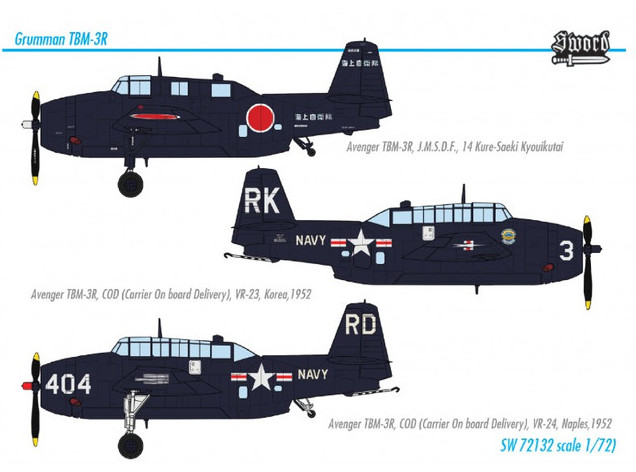6 November 2020: Norm Filer provided the following picture and notes on the TBM-3R that he built from the Sword kit described below:
"No significant issues. The usual vague instructions and soft plastic which leads to large sprue gates and sometimes not square mating surfaces. When it is done it looks good."Original Post:
Sword Models has just released 1/72 scale model kits of airplanes that are not sexy but were ground-breaking in their time, in this case examples of the repurposing the WW II General Motors TBM Avenger, which had been designed, developed, and initially produced by Grumman as the TBF. Attacking capital ships with torpedoes had gone out of fashion by the end of the war, but the TBM was big and sturdy and there were a lot of them left over. As a result, they were quickly and easily adapted to other missions now needing a suitable carrier-based airplane to accomplish. For more on the U.S. Navy TBMs, see http://thanlont.blogspot.com/2015/07/post-war-eastern-tbm-variants.html
All three kits contain the same plastic, including the canopies for each kit. Only the instructions and decals are different.
The first picture is the beautiful art on the cover of the box; the second are profiles of the markings in the kit.
SW72130 TBM-3SAvenger AS.3/4/6
Unfortunately, the identification of the kit contents is somewhat inaccurate in some places. Instructions and decals are provided for an AS.3 operated by the Royal Canadian Navy (not a TBM-3S, per se) and an ECM.6 operated by the Royal Navy. The AS.4 retained its turret, which is not provided in the kit; I'm not sure that there actually was an AS.6. Only a few (eight?) Royal Navy versions was converted to the ECM.6.SW72131 TBM-3S2 Avenger
You'll note that the RCN AS.3 depicted here has a slightly different canopy than the one in SW72130 and there are two variations of the -3S2 canopy. The TBM-3S2 was preceded by the very similar TBM-3S (consistent with U.S. Navy designation practice, there was no TBM-3S1), about which more later.SW72132 TBM-3R Avenger
Note that Sword also plans to issue yet another variant later this year, the very colorful TBM-3U. For more on this particular TBM, see https://tailspintopics.blogspot.com/2020/08/the-colorul-tbm-3u.html
I have yet to do more than fondle the plastic (and haven't seen any online reviews so far) but my first impression is that these kits are highly detailed and excellent quality. The builder will need to pay close attention to the pictorial instuctions because all of the parts, including canopies, for each variant are in each kit. There will be a few parts left over.
Another configuration detail that differentiates the various TBMs is the presence or absence of the external tailhook, which is dependent on which particular TBM-3 or -3E Bureau Number was the basis for the conversion. This is described in the first link above.











































